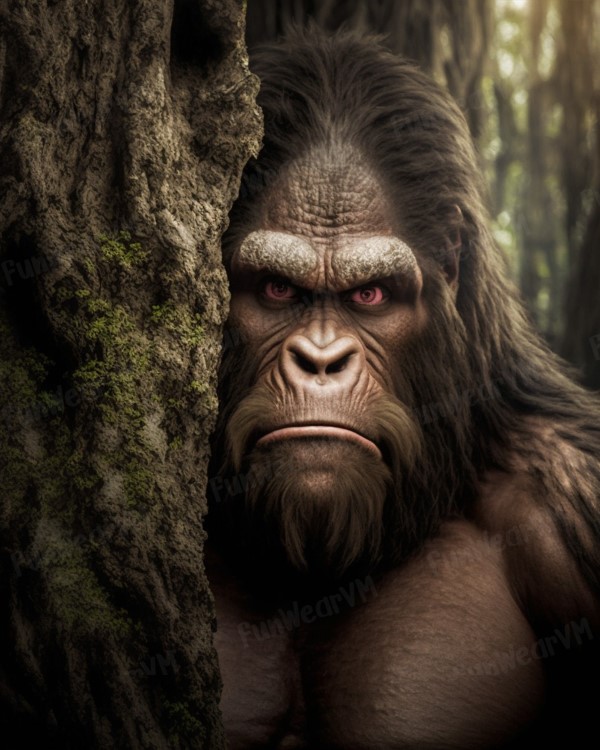
The Mogollon Monster is commonly described as a large bipedal creature, over 7 feet (2 m) tall with large, red eyes. Its body is said to be covered with long black or reddish brown hair, with the exclusion of the chest, face, hands and feet. It has a strong and pungent odor that has been compared to dead fish, skunk, decaying peat moss and snapping turtle musk.
The Mogollon Monster is allegedly nocturnal, omnivorous, territorial and sometimes violent. It is reported to walk with wide, inhuman strides; leave behind footprints measuring 22 inches (56 cm); mimic birds, coyotes and other wildlife; emit unusual whistle sounds; explore campsites after dark; build nests out of pine needles, twigs and leaves; hurl stones from hidden locations; and decapitate deer and other animals before eating them. The most distinctive feature of the Mogollon Monster is its blood-curdling scream, which has been described as sounding like a woman in great distress.
The Mogollon Monster is also known as the Arizona Bigfoot, as it shares many similarities with the more famous Sasquatch of the Pacific Northwest. However, some cryptozoologists believe that the Mogollon Monster is a distinct species or subspecies of hairy hominid that adapted to the arid climate and rugged terrain of Arizona.
Where does the Mogollon Monster live?
The majority of Mogollon Monster sightings are said to occur in the Ponderosa pine forests of the Mogollon Rim. The Mogollon Rim is a geological feature that rises about 2,000 feet (610 m) from the ground and spans 200 miles (320 km) across Arizona and New Mexico. It defines much of the eastern part of Arizona and separates the highlands from the lowlands. The Rim changes ecosystems along the way, from high Sonoran Desert to the largest contiguous Ponderosa Pine forest in the world.
Reported sightings range along Arizona’s Mogollon Rim, from Prescott north to Williams, southeast to Alpine, south to Clifton, and northwest back to Prescott. The race covers roughly 100 miles (160 km), climbing the Rim on six separate locations spending a lot of miles along the Rim, on top of the Rim and the challenging climbs up and down with climbs and descents at 30-45% grades at some points. Expect to climb a total of approximately 18,000 feet (5,500 m) along the way, never below 5,200 feet (1,600 m) and never above 8,000 feet (2,400 m) in elevation. While other races are certainly at higher elevations, and/or with more climbing, they certainly do not contain as rugged a terrain that is found on this course. This is a VERY technical course in many areas, specifically the Highline Trail, Donahue and the soon to be revered Myrtle Trail & Promontory Point. The first 40 miles (64 km) will have nearly 9,000 feet (2,700 m) in elevation gain. That coupled with the terrain, moderate elevation and intense Arizona sun will certainly take its toll on each runner.
What is the history of the Mogollon Monster?
The oldest known reported sighting of the Mogollon Monster was in 1903 by I.W. Stevens in The Arizona Republican newspaper. He claimed to have seen a creature near the Grand Canyon that had long white hair and a matted beard that reached to his knees. It wore no clothing and had claws at least two inches long on its talon-like fingers. He said that he found it drinking
the blood of two cougars and that it threatened him with a club and screamed an unearthly screech.
Another early sighting was by Don Davis in the mid-1940s when he was on a Boy Scout trip near Payson. He described seeing a huge creature with deep-set eyes and a face devoid of hair except for some along the sides. He said that its chest, shoulders and arms were massive and that it had hands larger than a human’s but very similar. He said that it smelled like dead peat moss and looked at him curiously before walking away into the forest.
Since then, there have been many more sightings reported by hunters, hikers, campers and residents of nearby towns. Some of these sightings have been documented by cryptozoologists such as Mitch Waite and Alex Hearn who have conducted field investigations and collected evidence such as footprints,
hair samples and video footage. However, no conclusive proof has been found to date to confirm or deny the existence of the Mogollon Monster.
Conclusion
The Mogollon Monster is one of the most intriguing and elusive cryptids in the world. It has fascinated and terrified many people who have encountered it or heard about it. It represents a mystery that challenges our understanding of nature and ourselves. Whether it is real or not, it is part of the folklore and culture of Arizona and deserves respect and curiosity.
References:
